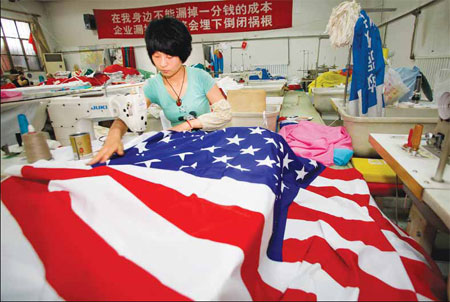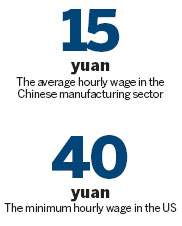
|
 |
|
Song Hongmin stitching a 2.85 by 1.92 meter US flag. She has been working at Beijing Jinggong Red Flag Factory Co for 10 years, earning 2,000 yuan ($313) a month. [Photo/ China Daily] |
Age of globalization means getting the best deal, Peng Yining reoports.
Every morning for the past 20 years, Karyn Abe has run the Stars and Stripes up the flagpole in her garden. Every evening, the flag is lowered and stored away, ready for use the next day.
The 68-year-old resident of Hawaii flies the 1.2 by 1.8 meter national emblem to show her allegiance to her country. But for Abe, and many other US citizens, the flag's provenance is as important as the ideals it embodies.
When she learned earlier this month that most US flags sold in the country are made in China, she checked the packaging in which her flag came.
"Thank goodness. My flag was made in the United States!" she said. "It seems a shame to outsource such an American-based thing as our own flag."
And it's not just Chinese-made flags. The matching blazers and uniforms that members of Team USA wore at the opening ceremony of the 2012 London Olympic Games caused an uproar. They, too, were made in China.
The flames were fanned by politicians, such as Senate Majority Leader Harry Reid, who said the uniforms - designed by the US couturier Ralph Lauren, but outsourced to China - should have been put in a pile and torched.
The world economy is characterized by a high degree of globalization. Companies export finished goods around the planet and source intermediate input from suppliers located in any number of countries, said Wang Zihong, director of the economics office of the Institute of American Studies at the Chinese Academy of Social Sciences.
"Manufacturing job losses are partly a result of the economic model in the US," he said. "People in the United States certainly have the right to complain about foreign-made flags and uniforms, but that won't change the economic structure, because the US also benefits from global production networks."
The issue of flags and Olympic uniforms is not an important one in terms of Sino-US economic relations, according to Dwight H. Perkins, professor of political science at Harvard Kennedy School in Massachusetts. Perkins said politicians like to stir up nationalist sentiment occasionally and the US flag and Olympic uniforms have a symbolic value in that regard.
For some, it's more basic than that. "No one in America tells you to fly the flag. It's just something that's done out of a feeling of patriotism, love of country and all it stands for. It just makes me feel good," said Abe.
"More specifically, with the flags and uniforms, it's a matter of American pride," she said. "The flag is the very symbol of our country, the Olympic uniform is the symbol of the aspirations America has for its athletes. I would hope that at least these two things, the flag and the Olympic uniforms, could be made entirely in America."
The US imported $3.6 million worth of flags in 2011. Around $3.3 million of that sum went to Chinese manufacturers, according to a report released by the US Department of Commerce in May.
|
 |
In a dim workshop at Beijing Jinggong Red Flag Factory Co, one of China's largest manufacturers of flags, dozens of workers stitch flags and banners. The fruits of their labors fly over Tian'anmen Square and were present in the stadiums during the 2008 Beijing Olympic Games.
Song Hongmin doesn't speak English, has never been to the United States, and doesn't know how many stars are featured on Old Glory, as the US flag is affectionately known. But the 31-year-old uses her sewing machine to stitch the four sides of a 2.85 by 1.92 meter US flag - roughly the size of one and a half double beds - in less than 100 seconds.
Song has been working at the factory for 10 years, earning 2,000 yuan ($313) a month.
"Flag manufacturing is a tough work, but we are lucky that we still have work to do," said Bai Zhiyue, the factory manager, who has seen the company's exports decline sharply as a result of the global economic downturn. "I believe a lot of smaller manufacturers won't make it to the end of the year. By then, lots of Chinese workers will be left in the lurch," he said.
In order to survive, Chinese-made products must improve, moving up the scale from "cheap" to "cheap, but high quality", according to Bai.
Beijing Jinggong has developed a new waterproof material. To demonstrate, Bai took a piece of fabric and poured water over it. The drops rolled across the surface like rain on a lotus leaf as he explained how the new material will soon be used to make flags destined for export, allowing them to fly proudly on rain-swept days instead of becoming sodden and hanging limply.


 Washington to remain focused on Asia-Pacific
Washington to remain focused on Asia-Pacific RQFII target blue chips amid bear market
RQFII target blue chips amid bear market Australian recall for top two exporters
Australian recall for top two exporters China fears new car restrictions
China fears new car restrictions